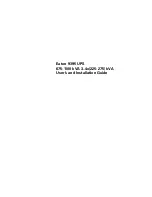
1029052
UPS 675-1100 kVA 3..4x(225-275) kVA
7
Revision 008
User’s and Installation Guide
1.4 Basic system configurations
The following basic UPS system configurations are possible:
•
Single UPS with two to three UPMs with a common battery and a standalone common battery
system with a battery disconnect
•
Single UPS with two to three UPMs with a common battery, a FI-UPM with a common battery, a
standalone common battery system with a battery disconnect.
•
Single UPS with two to three UPMs with separate batteries and a standalone separate battery
system with a battery disconnect for each UPM
•
Single UPS with two to three UPMs with separate batteries, an FI-UPM with a separate battery ,
and a standalone separate battery system with a battery disconnect for each UPM
•
Distributed bypass system with two to five UPSs and a customer-supplied tie cabinet
•
Distributed bypass system with two to five UPSs and a customer-supplied tie cabinet
The UPS system configuration can be enhanced by adding optional accessories such as a Remote
Emergency Power-off (REPO) control, RMP II, or X-Slot communication cards.
1.5 Using this manual
This manual describes how to install and operate the Eaton 9395 UPS (675-1100 kVA) cabinet. Read
and understand the procedures described in this manual to ensure trouble-free installation and
operation. In particular, be thoroughly familiar with the REPO procedure (see Section “Using the
Remote Emergency Power-off switch” on page 117).
The information in this manual is divided into sections and chapters. The system, options, and
accessories being installed dictate which parts of this manual should be read. At a minimum, Chapters
1 through 4 and Chapter 7 should be examined.
Read through each procedure before beginning the procedure. Perform only those procedures that
apply to the UPS system being installed or operated.
1.6 Conventions used in this manual
This manual uses these type conventions:
•
Bold type
highlights important concepts in discussions, key terms in procedures, and menu
options, or represents a command or option that you type or enter at a prompt.
•
Italic
type highlights notes and new terms where they are defined.
•
Screen type
represents information that appears on the screen or LCD.
Icon
Description
Information notes call attention to important features or instructions.






























